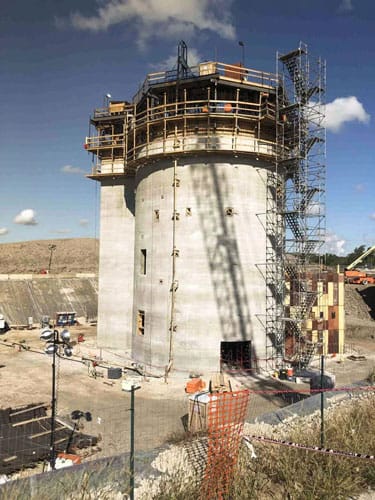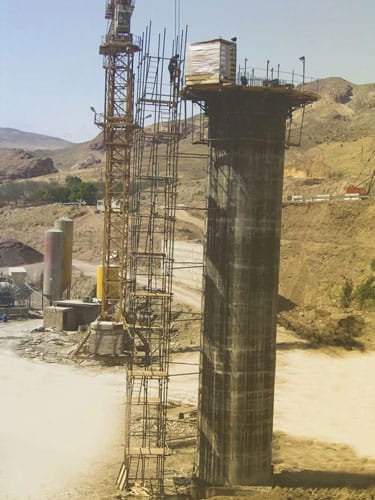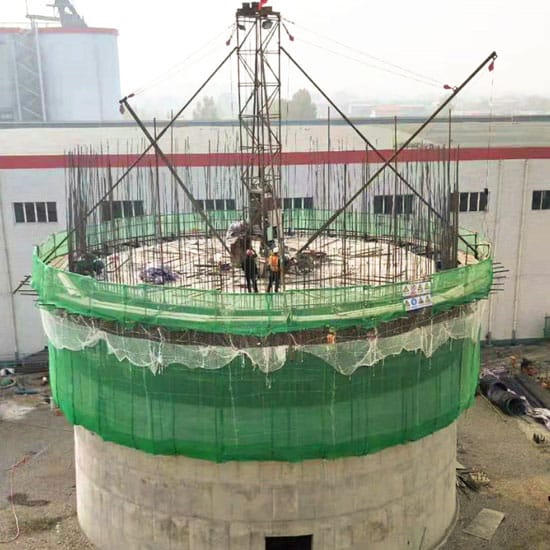Slip Formwork
Introduction

Easy international payment and all official international banks.

Be in touch with our experts at any time of the day or night.

Choose the products you need from B.F.S products

Be aware of discounts by registering on the site in addition to shopping.

How Slip Formwork Works
Slip formwork operates by utilizing a set of moving formworks that are continuously raised by hydraulic jacks or screw mechanisms. Concrete is poured at the base, and as it begins to set, the formwork slowly ascends, ensuring an uninterrupted construction process. The reinforcement is placed in advance, and workers ensure proper compaction and alignment as the formwork progresses.
This technique is advantageous because it allows for the continuous pouring of concrete, eliminating the need for cold joints that could weaken the structure. The process is especially beneficial for slipform concrete walls, as it results in a seamless and highly durable finish. Vertical slip formwork is commonly used in high-rise buildings, towers, and silos, where an uninterrupted, uniform structure is required. The controlled movement of the formwork ensures that the concrete cures uniformly, minimizing structural weaknesses.
Horizontal slip formwork, on the other hand, is widely utilized in constructing roads, tunnels, and bridge decks. The process involves a formwork system that moves horizontally as concrete is poured and compacted, ensuring an even and continuous surface. This method enhances efficiency and reduces the construction time significantly compared to traditional formwork techniques.
For successful slip formwork application, various factors must be carefully managed, including the concrete mix, formwork movement speed, and reinforcement placement. Proper planning and skilled workforce management are crucial to ensuring the accuracy and quality of the final structure. When executed correctly, slip formwork can lead to faster project completion, reduced labor costs, and structures with superior durability and strength. This makes it an invaluable technique in modern construction, particularly for large-scale and high-rise projects.
Types of Slip Formwork

Slip formwork is a construction technique that allows for the continuous pouring of concrete, leading to the rapid and efficient construction of various structures. There are several types of slip formwork, each designed for specific applications and construction needs. Understanding these types helps in selecting the appropriate method for a project.
Horizontal Slip Formwork
As the name suggests, horizontal slip formwork is utilized for horizontal elements, such as slabs and decks. This system allows for the construction of large, flat surfaces without the need for traditional formwork methods, which can be time-consuming and labor-intensive. By utilizing horizontal slip formwork, concrete can be poured continuously, ensuring a smooth and uniform finish.
Vertical Slip Formwork

Vertical slip formwork is a widely used construction technique that facilitates the continuous pouring of concrete for vertical structures. This method is particularly effective for building walls, columns, shafts, and silos, allowing for efficient and rapid construction. The system comprises a series of vertical panels, typically made of steel or plywood, that are assembled to form the desired shape of the structure.
One of the key features of vertical slip formwork is its ability to move upward as the concrete is poured. This is achieved using hydraulic jacks or mechanical systems that gradually raise the formwork, allowing for a seamless and uninterrupted pouring process. By eliminating the need for traditional formwork removal, vertical slip formwork reduces the risk of cold joints and improves the overall quality of the concrete structure.
Conical Slip Formwork
Conical slip formwork is a specialized type of slip formwork used primarily in constructing structures that require a tapering shape, such as silos, chimneys, and certain types of towers. The design of conical slip formwork facilitates the construction of vertical structures that narrow at the top, allowing for efficient and continuous casting of concrete. This type of formwork is particularly advantageous when dealing with elements that require precise geometrical shapes, as it can be tailored to meet specific architectural requirements.
The conical slip formwork system typically consists of several modular sections that can be adjusted to create the desired conical shape. Each section is equipped with hydraulic jacks or mechanical systems that allow it to be raised incrementally as the concrete sets. This continuous process minimizes the risk of cold joints and ensures a smooth, uniform surface finish. The formwork is designed to support the weight of the freshly poured concrete while maintaining stability throughout the construction process.
Applications of Slip Formwork
Slip formwork is utilized in various construction applications, primarily where speed and efficiency are crucial. One of the most common uses is in the construction of high-rise buildings. The continuous pouring method allows for the rapid creation of walls and cores, enabling faster completion of these complex structures.
Another significant application is in the construction of bridges, particularly for pillars and support structures. Slip formwork provides the stability needed to pour large volumes of concrete while maintaining precision in shape and alignment.
Additionally, slip formwork is ideal for creating cylindrical structures, such as silos and tanks. The adaptable nature of the formwork allows it to accommodate various diameters and heights, ensuring effective construction of these essential components in industrial and agricultural settings.
In the energy sector, slip formwork is often employed for constructing chimneys and smokestacks, where a conical design is required. This technique enables the efficient formation of tall, tapering structures that meet specific regulatory standards.
Overall, the versatility and efficiency of slip formwork make it a valuable technique in various sectors, including residential, commercial, industrial, and infrastructure projects, contributing to the advancement of modern construction practices.
Key Components of Slip Formwork System
A slip formwork system comprises several key components that work together to facilitate the continuous pouring of concrete and ensure the stability and quality of the structure being built. Understanding these components is essential for effective implementation and operation.
Form Panels
These are the primary elements of slip formwork, typically made of steel or plywood. Form panels are assembled to create the desired shape of the structure, providing the surface against which the concrete is poured. They are designed to withstand the pressure of freshly poured concrete while maintaining their integrity.
Lifting Mechanism
This component consists of hydraulic jacks or mechanical systems that allow the formwork to move upward or outward as the concrete sets. The lifting mechanism is crucial for maintaining a continuous pouring process and ensuring the smooth transition of the formwork.
Support System
To ensure stability during the pouring process, a robust support system is necessary. This may include props, braces, and scaffolding that hold the formwork in place and prevent movement or collapse.
Concrete Distribution System
This component is responsible for delivering the concrete mix to the formwork. It can include chutes, pumps, or conveyors designed to facilitate the efficient placement of concrete as the formwork rises.
Finish System
To achieve a smooth surface finish, a finishing system may be integrated. This could involve screeds or vibrators that help compact and level the concrete as it is poured.
Together, these components create an efficient slip formwork system that enhances productivity, safety, and the overall quality of construction projects.
Comparison: Slip Formwork vs. Traditional Formwork

When comparing slip formwork to traditional formwork, several key differences emerge that impact efficiency, cost, and construction quality. Both methods are used to shape concrete structures, but they cater to different project needs.
Horizontal slip formwork is designed for the continuous pouring of horizontal elements like slabs and decks. This method allows for rapid construction, significantly reducing labor and time compared to traditional methods, which require extensive setup and teardown for each section. The continuous nature of horizontal slip formwork minimizes cold joints, leading to a more uniform and durable surface.
In contrast, vertical slip formwork excels in constructing vertical elements such as walls and columns. Like its horizontal counterpart, it facilitates continuous pouring, which helps maintain structural integrity and reduces construction time. Traditional vertical formwork often involves a slower process, requiring workers to remove and reposition forms, which can lead to delays and potential quality issues.
Additionally, slipform concrete walls benefit from the seamless pouring process, resulting in stronger and more stable structures. Traditional methods can create weak points due to multiple joints and connections.
Overall, while traditional formwork has its place in construction, slip formwork—both horizontal and vertical—offers superior efficiency, quality, and safety, making it a preferred choice for modern construction projects. The ability to create strong, durable structures quickly is increasingly vital in today’s fast-paced construction environment.
Challenges and Limitations of Slip Formwork
While slip formwork offers numerous advantages, it also presents several challenges and limitations that construction teams must consider. One significant challenge is the initial setup and design complexity. Developing an effective slip formwork system requires careful planning and precise engineering to ensure it can withstand the pressure of freshly poured concrete while maintaining the desired shape. This complexity can lead to higher initial costs and longer preparation times compared to traditional formwork methods.
Another limitation is the dependency on skilled labor. Operating slip formwork systems, especially those involving hydraulic lifting mechanisms, requires specialized knowledge and experience. A lack of skilled workers can hinder project progress and impact the overall quality of the work.
Additionally, environmental factors can pose challenges. Weather conditions, such as extreme temperatures or heavy rain, can affect the curing process of concrete, potentially compromising structural integrity. Construction teams must be prepared to manage these conditions effectively to ensure successful outcomes.
Finally, while slip formwork is adaptable, it may not be suitable for all project types, particularly smaller or irregularly shaped structures. In such cases, traditional formwork may still be the more practical choice. Addressing these challenges is crucial for maximizing the benefits of slip formwork in construction projects.
Conclusion: The Future of Slip Formwork in Construction
Slip formwork represents a significant advancement in construction techniques, offering numerous benefits such as increased efficiency, improved structural quality, and enhanced safety. As the construction industry continues to evolve, the demand for faster and more cost-effective building methods will drive the adoption of slip formwork systems.
With advancements in technology, including automated systems and improved materials, the capabilities of slip formwork are expanding, making it suitable for a wider range of applications. Additionally, the emphasis on sustainability in construction will further promote slip formwork, as its reusability and reduced waste contribute to eco-friendly building practices.
Despite the challenges and limitations, the advantages of slip formwork position it as a key player in modern construction. As more projects leverage this innovative technique, slip formwork is likely to play a vital role in shaping the future of the industry, leading to faster, safer, and more efficient construction processes.
What is slip formwork?
Slip formwork is a construction technique that allows for the continuous pouring of concrete using a movable formwork system. It enhances efficiency and quality by enabling rapid construction of vertical and horizontal elements without cold joints
FAQs on Slip Formwork
What are the types of slip formwork?
The main types include:
- Horizontal Slip Formwork: Used for slabs and decks.
- Vertical Slip Formwork: Ideal for walls and columns.
- Conical Slip Formwork: Designed for tapering structures like silos and chimneys.
What are the advantages of slip formwork?
Advantages include increased construction speed, reduced labor costs, improved structural integrity, and enhanced safety due to fewer manual handling requirements at heights.
What challenges are associated with slip formwork?
Challenges include the complexity of initial setup, reliance on skilled labor, sensitivity to weather conditions, and potential unsuitability for smaller or irregularly shaped projects.
How does slip formwork compare to traditional formwork?
Slip formwork offers superior efficiency and quality by allowing continuous pouring, which minimizes cold joints and enhances structural strength, whereas traditional formwork requires more time for setup and removal.
How can slip formwork efficiency be improved?
- Precise planning of concrete mix and pouring schedule.
- Using high-quality materials to reduce maintenance and adjustments.
- Employing experienced workers and supervisors.
- Regularly inspecting and maintaining hydraulic systems.